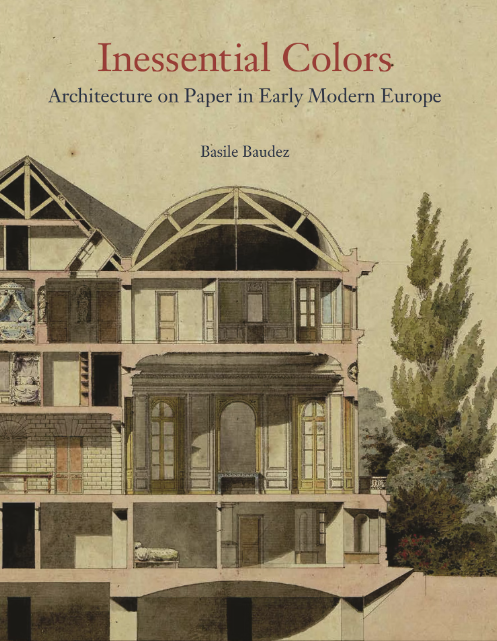Announcement of the 2022 SAHGB Award Winners
We are pleased to congratulate the winners of this year’s awards.
Follow this link if you wish to read the results of the SAHGB Awards decided Dec 2023
Alice Davis Hitchcock Medallion
Awarded annually since 1959 to a monograph that makes an outstanding contribution to the study or knowledge of architectural history.
This year’s winner is:
Basile C. Baudez’s Inessential Colors: Architecture on Paper in Early Modern Europe (Princeton University Press) - which the panel commend as a landmark work, beautifully written, methodologically innovative and which will have significant impact on future studies.
Elizabeth McKellar, on behalf of the judging panel, commented:
“The judges praised this as an original, complex and ambitious work which examines changes in architectural drawing c. 1500-1800. The author skilfully weaves an investigation of the changing use of colour in architectural representation to argue for new understandings of draughtsmanship and its place in architectural practice. Furthermore, Baudez reveals how histories of the practice of architecture are inextricably interwoven with those of painting, engineering and cartography as well as the professional, commercial and institutional networks that shaped its activities. The book is to be commended for its mastery of a huge range of secondary literature across the broad chronological and geographical sweep of both southern and northern Europe (including Britain) in an integrated approach. The book is beautifully and generously illustrated incorporating a breath-taking range of sources, many of them little-known. The quality of this visual material together with the clarity of the writing combine to produce a powerful re-assessment of the role of coloured maps, plans and drawings in communicating and defining early modern architecture in Europe”.
Inessential Colors is published by Princeton University Press.
Colvin Prize
Awarded annually to the author or authors of an outstanding work of reference of use and value to architectural historians and the discipline of architectural history, across a range of formats.
This year’s winner is:
Mark Girouard, collected by Blanche Girouard, A Biographical Dictionary of English Architecture, 1540 - 1640 (Paul Mellon Centre for Studies in British Art)
Murray Fraser, on behalf of the judging panel, commented:
“This book is based upon exemplary scholarship and fills a century-wide gap in our detailed understanding of the course of English architectural history. Beautifully written, it contains mostly novel material and embraces a remarkably wide range of architects (as we would define them today). The book is an instant classic which will no doubt stand as the definitive work on the topic for a very long time. In the judges’ view there was very close competition from the Survey of London’s entry this year but in the end the sheer originality and depth of Mark Girouard’s book swayed the decision, in what is sadly a posthumous award for one of Britain’s best-ever architectural historians.”.
A Biographical Dictionary of English Architecture, 1540 - 1640 is published by Paul Mellon Centre for Studies in British Art.
Commended:
Survey of London, Vols 54 & 55: Whitechapel (Peter Guillery, ed.)
“This publication continues the world-renowned scholarly output of the Bartlett’s Survey of London team, while also adding an important update in using a crowd-sourced website to draw upon the local community’s knowledge and memory of Whitechapel’s architecture. This fresh research tool works superbly when set against the rigorous archival research for which the Survey of London has become so rightly admired. In recognition of its excellent and exhaustive contribution to knowledge the judges agreed unanimously to award this entry a Commendation, noting that it follows in the wake of the Survey of London team having previously won the Colvin Prize in 2018”.
Heritage Research Award
The SAHGB-IHBC Heritage Research Award recognises and celebrates the quality of architectural-historical research produced by colleagues in heritage and conservation practice, as private consultants and in non-departmental public bodies.
Winning Research:
The Old Royal High School, Edinburgh: Simpson and Brown Heritage Consultancy Team (collected by Nicholas Uglow and Christian Clarkson)
Malcolm Airs, on behalf of the judging panel, commented:
“The panel was unanimous in its recommendation that the 2022 Heritage Research Award should be made to the Simpson & Brown Heritage Consultancy Team for their submission on the Old Royal High School Edinburgh. Based on significant original research, it makes a major contribution to our understanding of the historic evolution of the building and the changes that have been made since it was first built. It is clearly structured and appropriately illustrated. It is directly relevant to the current proposal for a new use and fully addresses all the criteria that are specified in the assessment process”.
Hawksmoor Essay Prize
Awarded to the author of the best essay submitted in competition, and aimed at graduate students, early career researchers and professionals in architectural history, heritage and conservation practice.
This year’s winner is:
Holly Smith (University College London), Park Hill, The Architecture of community and the postwar British welfare state 1953 - 1969
Max Sternberg, on behalf of the judging panel, commented:
“The housing estate Park Hill in Sheffield designed by Jack Lynn and Ivor Smith is widely regarded as one of the heroic examples of British post-war modernism. This lucidly written and engaging essay offers a substantial revision to the standard accounts of Park Hill.
“Based on original archival research it shows that the ‘street in the sky’ concept was not derived from the pre-existing morphology but was in fact imported from a variety of sources in architectural culture, including the work of Peter and Alison Smithson. Furthermore, the author also argues persuasively that the designers and their public clients, did not so much aim to strengthen the existing working class community, but cleanse it of its perceived defects, and replace it with one that was respectable. By coming at Park Hill from a number of different angles (architectural, political, sociological), it chips away at the architectural mythologies of the estate to demonstrate its anachronisms, contradictions, ambiguities and realities, as well as the ‘paternalistic’ attitudes of its promoters”.
Commended:
Jake Bransgrove (University of Cambridge), The Fifth Column: Herbert Baker and the Architecture of Indian Dominionhood
Max Sternberg commented: “Herbert Baker was a leading architect active across the British Empire, yet his work in England has been relatively neglected. This well written and carefully referenced essay focuses on Baker’s India House on the Strand built between 1928 and 1930, interrogating its dynamic relationship to colonial architecture elsewhere. It is particularly successful in shedding light on the wider political context of Baker’s work in the imperial capital. The judges were impressed with the way the essay drew out the subtle thinking behind Baker’s design in his attempt to connect London, India, and the idea of imperial Dominionhood through built form. The skilful analysis of these concerns from a post-colonial perspective was clearly designed to encourage the reader to reflect upon how a building such as India House can, indeed, must, be understood in a post-imperial age”.
Commended:
Alborz Dianat (University of Edinburgh), Interwar Britain, an example for all nations?
Max Sternberg commented: “Tracing the connections between strands of British modernism and continental Europe, this enjoyable essay is based on a commendable sourcing of international journals and reports and offers new material of interest. The discussion of the international interest in English domestic comfort and the family home in particular was persuasive. The judges were impressed with the essay’s attempt not only to challenge conventional wisdom on the extent to which Modernist ideas in Britain infiltrated continental European architectural thinking, but also the author’s determination to shed further light on this phenomenon, correcting the record in the process. The reading of these influences across a number of contemporary European language publications was both convincing and revealing in the way it brought these various currents of thinking and influence together in a coherent and stimulating history. “
Dissertation Prize
This prize celebrates the outstanding work in architectural history being carried out by postgraduate students on taught Masters-level courses in UK universities. The prize awards innovative and critical thinking in and around the subject of Architectural History, broadly conceived, which supports the Society’s aim to help create ‘a bigger discipline’.
This year’s winner is Stella Saunt Hills, Unseen in the City: introducing a lesbian urban history of London between 1953 and 1963
Luca Csepely-Knorr, on behalf of the judging panel, commented:
“This eloquent thesis is based on thorough and rigorous research but presented in highly accessible language which creates a sense of the atmosphere of the time in London. Its bringing of an explicitly lesbian lens to urban space and its attempt at addressing an imbalance in the city’s queer history, one where lesbian lives have been overlooked in favour of male homosexual ones, is highly significant and important. The judges found the author’s self-awareness and the admission that the research is partial for its whiteness, class inequality and lack of gender diversity within the lesbian category, to be very impressive. The use of oral history as a methodology and the mapping developed from it was also commendable”.
Commended:
Clara Asperilla Arias (The Architectural Association School of Architecture), From Autarchy to Synergy: The Spanish Countryside and the Production of Rurality 1950-2020
“This research contributes to the current reappraisal of the countryside in architectural and urban design discourse. It proposes a new take on rurality, from the perspective of the domestic and ecologies of care, which makes a significant contribution to the growing discourse on the rural. The thesis interweaves cultural references, architectural analysis and the historical background persuasively and constructs a thorough framework for the critique of the Spanish countryside’s current state. The panel wishes to congratulate the student on the design component of the thesis and its clear, high-quality analytical and projective presentation”.
The SAHGB’s internationally prestigious awards programme celebrates the best in research and publishing in architectural history. It is open and inclusive, celebrating diversity of approach in histories of the built environment as broadly conceived. You do not need to be a member to nominate or be nominated.
Full lists of the judging panels for this year’s prizes can be found here, alongside more information on the awards programme, including how to nominate works.


